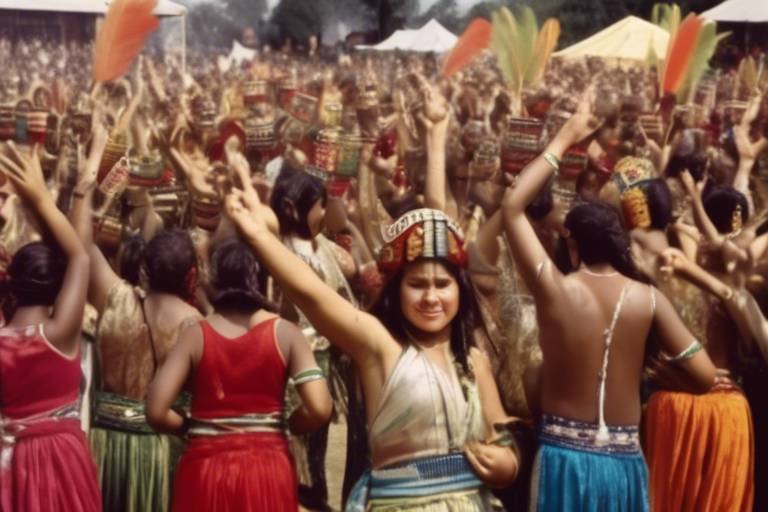The Sacred Texts of Ancient Indian Religions
Exploring the ancient Indian religions unveils a treasure trove of sacred texts that have shaped the spiritual landscape of the region for millennia. From the profound hymns of the Vedas to the moral dilemmas in the Mahabharata, these texts offer insights into the beliefs, values, and philosophies that have guided generations of seekers on their spiritual journeys.
The Vedas, the oldest scriptures of Hinduism, stand as pillars of wisdom, offering a glimpse into the early societal and spiritual practices of ancient India. These hymns and rituals not only provide a window into the past but also serve as a foundation for the rich tapestry of Indian religious traditions that have evolved over time.
Delving deeper, the Upanishads beckon seekers to ponder the nature of reality and the self. Considered the culmination of Vedic thought, these philosophical texts delve into metaphysical concepts, ethical dilemmas, and the quest for liberation, offering profound teachings that transcend time and space.
Amidst the vast ocean of Indian scriptures, the Bhagavad Gita shines as a beacon of spiritual guidance. Through the dialogue between Prince Arjuna and Lord Krishna, this revered text imparts timeless wisdom on duty, righteousness, and the essence of existence, serving as a spiritual compass for navigating life's challenges.
Embark on the epic journey of the Ramayana, a narrative that weaves together the threads of duty, righteousness, and devotion. Through the adventures of Prince Rama, this ancient tale illustrates the triumph of good over evil, embodying the eternal struggle between light and darkness that resonates with readers across generations.
Step into the battlefield of the Mahabharata, where moral dilemmas and cosmic principles converge in a tale of epic proportions. Through the Kurukshetra War between the Pandavas and Kauravas, this monumental epic poem explores the intricacies of human nature, divine intervention, and the eternal struggle between right and wrong.
Explore the mystical realms of the Puranas, where myths, legends, and moral lessons intertwine to illuminate the vast tapestry of Hindu cosmology. These ancient texts not only preserve cultural traditions but also offer spiritual insights into the genealogy of deities and the eternal dance of creation and destruction.
Find solace in the contemplative wisdom of the Aranyakas, texts that delve into the deeper meanings of sacrificial rituals and meditative practices. Associated with forest-dwelling hermits, these texts bridge the gap between the ritualistic hymns of the Vedas and the philosophical musings of the Upanishads, offering seekers a path to transcendence and self-realization.

Vedas
This article explores the significance and impact of the sacred texts in ancient Indian religions, such as the Vedas, Upanishads, Bhagavad Gita, and more, shedding light on their teachings and influence.
The Vedas, the oldest scriptures of Hinduism, are a collection of hymns and rituals that form the foundation of Indian religious traditions. These ancient texts provide profound insights into the early Indian society and spirituality, offering a glimpse into the beliefs and practices of the ancient Indian civilization.
The Vedas are divided into four main collections: Rigveda, Samaveda, Yajurveda, and Atharvaveda. Each Veda consists of hymns, prayers, and rituals dedicated to various deities, reflecting the spiritual and philosophical quests of the ancient seers and sages.
These sacred texts are revered for their poetic beauty, philosophical depth, and spiritual wisdom. They address fundamental questions about the nature of existence, the relationship between humans and the divine, and the principles of ethical living. The Vedas serve as a source of inspiration and guidance for seekers on the path of spiritual enlightenment.

Upanishads
The Upanishads, a collection of philosophical texts that delve deep into the nature of reality and the self, hold a revered position in ancient Indian literature. These profound scriptures are considered the culmination of Vedic thought, offering seekers spiritual insights and wisdom that transcend the material world. Exploring metaphysics, ethics, and the ultimate goal of liberation, the Upanishads present a holistic view of existence and the interconnectedness of all beings.
Within the Upanishads, one can find intricate discussions on the nature of the soul (Atman) and its relationship to the universal consciousness (Brahman). Through dialogues between sages and students, these texts unravel the mysteries of the universe and the eternal quest for self-realization. The Upanishads challenge readers to contemplate the impermanence of the physical world and seek the eternal truth that lies beyond the illusions of Maya, or the material realm.
One of the central themes of the Upanishads is the concept of Moksha, or liberation from the cycle of birth and death (Samsara). By delving into the nature of the self and the ultimate reality, these texts guide individuals on a spiritual journey towards enlightenment and self-discovery. The Upanishads emphasize the importance of introspection, meditation, and the pursuit of knowledge as pathways to transcending worldly suffering and attaining spiritual freedom.
Furthermore, the Upanishads advocate for ethical living and righteous conduct as essential components of spiritual growth. By aligning one's actions with universal principles of truth, righteousness, and compassion, individuals can harmonize their inner selves with the cosmic order, leading to inner peace and spiritual fulfillment.

Bhagavad Gita
The , often referred to as the Gita, is a revered Hindu scripture that holds profound wisdom and spiritual guidance. It is a sacred dialogue between Prince Arjuna and Lord Krishna, taking place on the battlefield of Kurukshetra. In the midst of a moral dilemma, Arjuna seeks counsel from Krishna on his duty as a warrior and the nature of righteousness.
The Bhagavad Gita delves into deep philosophical concepts, exploring the eternal principles of duty (dharma), the selfless performance of one's responsibilities, and the path to spiritual liberation. Through its verses, the Gita imparts timeless teachings on the importance of selflessness, devotion, and the pursuit of knowledge.
One of the key themes of the Bhagavad Gita is the idea of Karma Yoga, the yoga of selfless action. It emphasizes the importance of performing one's duties without attachment to the fruits of the actions, promoting a sense of detachment and equanimity in the face of success or failure.
Furthermore, the Gita elucidates the concept of Bhakti Yoga, the path of devotion, highlighting the significance of surrendering to the divine with unwavering faith and love. It emphasizes the power of devotion in cultivating a deep connection with the divine and attaining spiritual realization.
Throughout the Bhagavad Gita, Lord Krishna imparts profound spiritual truths and practical guidance to Arjuna, addressing fundamental questions about life, duty, morality, and the nature of reality. It serves as a spiritual guide for individuals facing moral dilemmas, inner conflicts, and existential questions, offering clarity and direction in navigating life's challenges.
The Bhagavad Gita's universal message transcends time and culture, resonating with seekers of wisdom and truth across the world. Its teachings continue to inspire and enlighten readers, guiding them on the path of righteousness, self-discovery, and spiritual fulfillment.

Ramayana
This article delves into the profound significance and enduring impact of the sacred texts in ancient Indian religions, encompassing revered scriptures such as the Vedas, Upanishads, Bhagavad Gita, and more. By shedding light on their teachings and influence, we uncover the spiritual treasures that have shaped the beliefs and practices of millions for centuries.
The stands as an epic narrative that captivates the hearts and minds of readers with its timeless tale of virtue, duty, and devotion. Through the adventures of Prince Rama, this ancient scripture embodies the eternal struggle between good and evil, showcasing the triumph of righteousness and the power of unwavering faith.

Mahabharata
The is a monumental epic poem that stands as one of the most revered and significant texts in ancient Indian literature. Spanning over 100,000 verses, the Mahabharata narrates the legendary Kurukshetra War between the Pandavas and Kauravas, symbolizing the eternal battle between good and evil. This epic not only chronicles the intricate plot of the great war but also delves deep into the complexities of human nature, morality, and cosmic principles.
At the heart of the Mahabharata lies the Bhagavad Gita, a profound dialogue between Prince Arjuna and Lord Krishna on the battlefield of Kurukshetra. This sacred conversation addresses fundamental questions of duty, righteousness, and the nature of existence, offering timeless wisdom and spiritual guidance to seekers of truth. The teachings of the Bhagavad Gita continue to inspire individuals worldwide, transcending boundaries of time and culture.
Interwoven within the narrative of the Mahabharata are intricate moral dilemmas, divine interventions, and philosophical discourses that illuminate the complex tapestry of human life. Through the characters of the epic, such as the noble Yudhishthira, the valiant Arjuna, and the enigmatic Krishna, the Mahabharata imparts valuable lessons on loyalty, sacrifice, and the pursuit of righteousness.
Furthermore, the Mahabharata serves as a reservoir of cultural heritage, preserving ancient Indian traditions, customs, and societal norms. Its vivid portrayal of familial relationships, political intrigues, and ethical conundrums offers a panoramic view of human existence, reflecting the eternal struggle between light and darkness, truth and falsehood.
As readers immerse themselves in the rich tapestry of the Mahabharata, they are confronted with profound philosophical inquiries and ethical quandaries that resonate with the complexities of contemporary life. The epic's enduring relevance lies in its ability to transcend time and space, inviting individuals to reflect on the eternal themes of justice, duty, and the eternal quest for truth.

Puranas
The Puranas, a significant genre of ancient Indian texts, play a crucial role in elucidating the rich tapestry of Hindu cosmology and spiritual wisdom. These texts are not merely repositories of myths and legends but serve as profound sources of moral lessons and cultural heritage. Within the vast expanse of the Puranas, one can discover intricate narratives that detail the genealogy of deities, the cyclical nature of creation, and the eternal struggle between good and evil.
Each Purana is a treasure trove of stories that not only entertain but also impart valuable teachings on ethics, duty, and devotion. Through these tales, readers are transported to a realm where gods and demons engage in cosmic battles, sages impart timeless wisdom, and virtuous deeds are rewarded while vice is punished. The Puranas serve as a bridge connecting the divine with the mortal, offering insights into the workings of the universe and the eternal principles that govern existence.
Furthermore, the Puranas provide a glimpse into the cultural ethos of ancient India, preserving traditions and rituals that have been passed down through generations. These texts serve as repositories of knowledge, documenting the customs, beliefs, and practices of a bygone era, allowing readers to immerse themselves in the rich tapestry of Indian heritage.

Aranyakas
This article explores the significance and impact of the sacred texts in ancient Indian religions, such as the Vedas, Upanishads, Bhagavad Gita, and more, shedding light on their teachings and influence.
The Aranyakas are a fascinating collection of texts associated with forest-dwelling hermits in ancient India. These texts serve as a bridge between the ritualistic practices outlined in the Vedas and the philosophical musings of the Upanishads. In the tranquil setting of the forests, these hermits contemplated the deeper meanings of sacrificial rituals and sought spiritual enlightenment through meditation and introspection.
Exploring the Aranyakas reveals profound insights into the spiritual journey of individuals seeking a deeper connection with the divine. These texts delve into the symbolism behind rituals, the significance of offerings, and the meditative practices that lead to self-realization. By contemplating the mysteries of existence in the solitude of the forest, the sages in the Aranyakas pondered the interconnectedness of all life and the ultimate truth that transcends the material world.
Furthermore, the Aranyakas emphasize the importance of living in harmony with nature and recognizing the sacredness of the natural world. Through their contemplative practices, the hermits in the forests sought to align themselves with the cosmic order and understand their place within the vast tapestry of existence. The Aranyakas invite readers to reflect on the deeper meanings of life and the interconnectedness of all living beings, fostering a sense of reverence for the divine presence that permeates the universe.
By studying the Aranyakas, one can gain a deeper appreciation for the spiritual heritage of ancient India and the profound wisdom that emanates from the forest-dwelling sages. These texts offer a unique perspective on the pursuit of spiritual enlightenment and the quest for self-realization, inviting readers to embark on a journey of introspection and contemplation in search of the ultimate truth.
Frequently Asked Questions
- What are the Vedas?
The Vedas are the oldest scriptures of Hinduism, consisting of hymns and rituals that form the foundational texts of Indian religious traditions. They provide insights into early Indian society and spirituality.
- What is the significance of the Upanishads?
The Upanishads are philosophical texts that explore the nature of reality and the self. They are considered the culmination of Vedic thought, offering profound teachings on metaphysics, ethics, and liberation.
- What is the Bhagavad Gita?
The Bhagavad Gita is a revered Hindu scripture that presents a dialogue between Prince Arjuna and Lord Krishna on duty, righteousness, and the nature of existence. It serves as a spiritual guide for navigating life's challenges.
- What is the Ramayana about?
The Ramayana is an epic narrative that follows the adventures of Prince Rama, illustrating the concepts of dharma (duty) and righteousness. It showcases the triumph of good over evil and the power of devotion.
- What is the Mahabharata?
The Mahabharata is one of the longest epic poems globally, recounting the Kurukshetra War between the Pandavas and Kauravas. It weaves together moral dilemmas, divine intervention, and cosmic principles.
- What do the Puranas contain?
The Puranas are a genre of ancient Indian texts that contain myths, legends, and historical narratives elucidating Hindu cosmology, genealogy of deities, and moral lessons. They preserve cultural traditions and spiritual wisdom.
- What are the Aranyakas?
The Aranyakas are texts associated with forest-dwelling hermits that explore rituals, meditations, and philosophical reflections on the deeper meanings of sacrificial practices. They bridge the gap between the Vedas and the Upanishads.



















